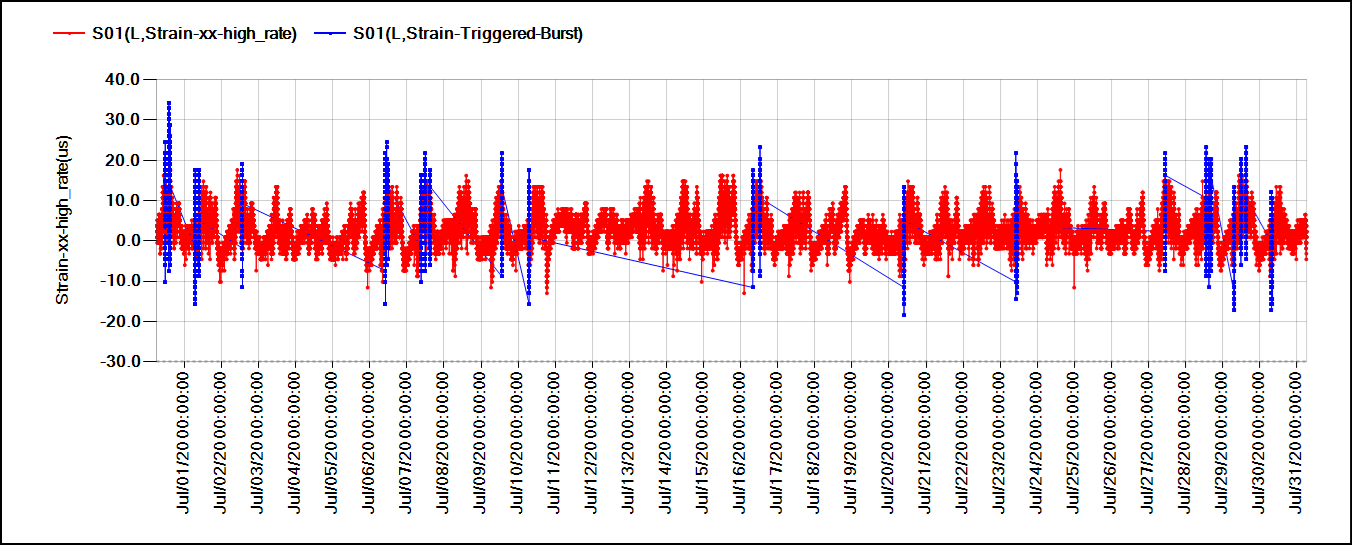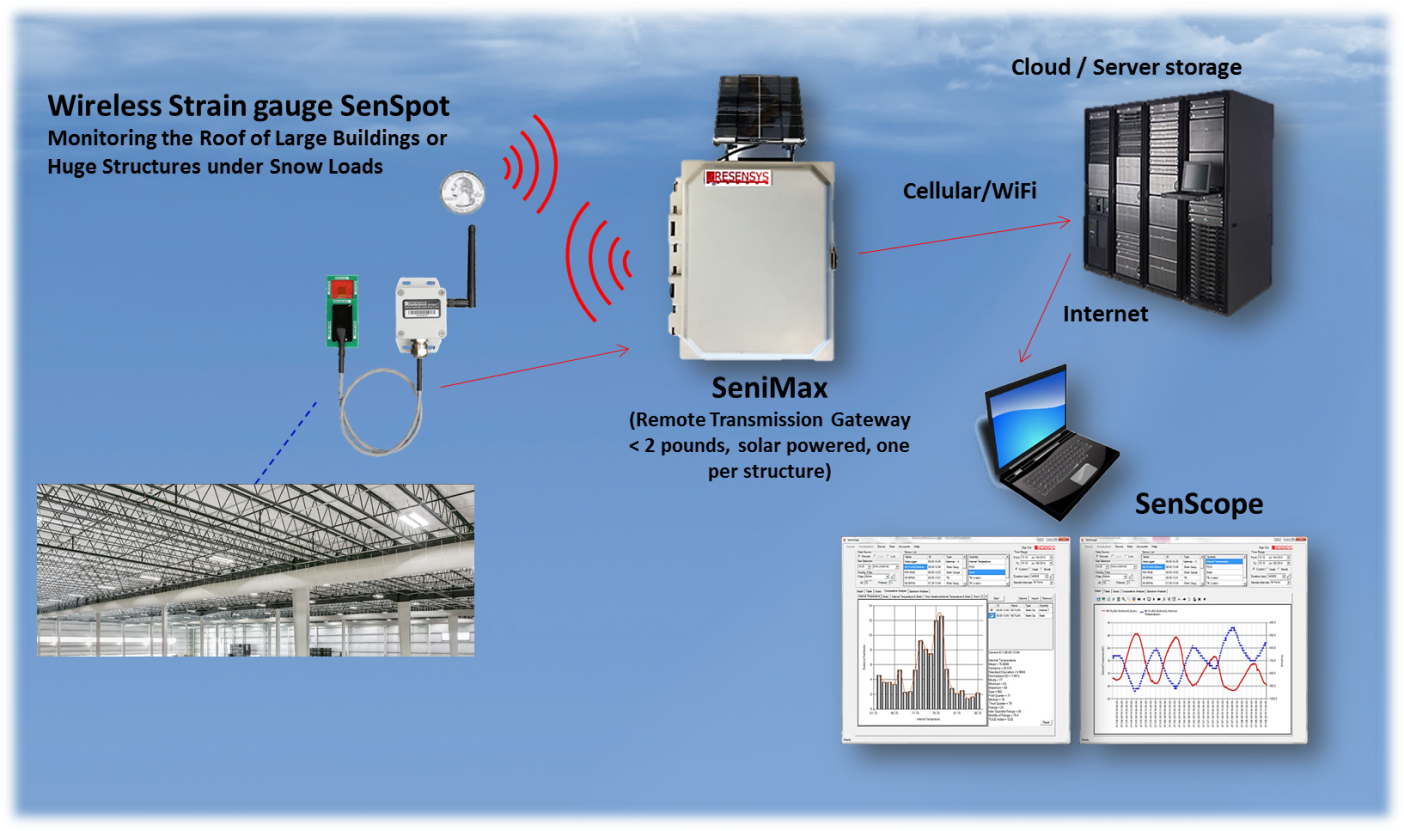Home > Applications > Monitoring the Roof under Snow Loads
Buildings with large roof spans such as large warehouses and factories, mall buildings or airport terminal structures in snowy areas are at risk of damage and collapse from the weight of extreme snow, which can huddle on their extensive roofs during the cold seasons.
Due to a variety of potential excessive burden conditions, including extreme snow depth/level (amount) and rain levels when temperatures are low, there is a possibility that roofs will be overloaded beyond the expected worst scenario of load conditions during the lives of the large buildings or structures.
Structural failure due to roof snow loads may be linked to several possible causes, including but not limited to the following: actual snow load significantly exceeds design snow load, drifting and sliding snow conditions, deficient workmanship, insufficient operation and maintenance, improper design, inadequate drainage design, insufficient design in older buildings. Insufficient design is often related to inadequate snow load design criteria in the building code in effect when the building was designed.
In the case of extreme or unanticipated weather events causing overload, poor workmanship or inadequate/ improper design, structural elements of buildings in weather-affected areas may not be able to react properly to extreme loads due to heavy snow or other compounding weather events.
In areas where extraordinary snow loads are anticipated (like sub-mountainous states), the structure of buildings are designed to accommodate significant snow loads. In regions with infrequent snow events, however, snow loads on the roofs of buildings are assumed to be of lesser significance. This increases the likelihood that abnormal weather conditions can result in destruction to the roof of the buildings or even their failure and collapse.
Winter storms, bringing rain, snow and ice can cause several roof collapses each year. This kind of damage may cost millions of dollars in property damage as well as disrupting daily operations. Thus, it is important to monitor these roofs permanently and continuously to prevent huge financial and property loss.
Additionally, unidentified damage during one weather event can decrease the ability of the structure to withstand future (and perhaps lesser) events that the structure would otherwise be expected to withstand. It is not just a significantly large snowstorm that can damage a roof system. Even in the absence of one “block buster” snow storm, frequent snow events that do not have enough time to melt can collect and exceed the roof design’s live load. The rain that can follow snow events can also saturate the snow, which will significantly increase snow weight.
The applicable, measurable and monitorable quantities in monitoring of structure’s roof are strain, and ambient temperature.
Resensys’ structural health monitoring (SHM) system can provide peace of mind to building owners or authorities who have concerns about potential overload conditions and the corresponding risk of structural damage and possible human injury. The Resensys SHM system can be used for measuring static and dynamic loads of the building structure, providing insights into how critical structural elements are experiencing and responding to loading conditions.
Wireless Strain SenSpot sensors are able to monitor strain and corresponding stress/loads occurring on flat roofs or roofs with inclination by installing them on the measurement nodes. These gauges are able to monitor loads occurring on flat roofs or roofs with inclination. By measuring strain on the main roof girders, overall load on the building structure can be assessed, providing a real time picture of roof stress/ load conditions even when physical inspection is impossible due to icy or wet weather conditions.
The calculation and evaluation of loads can be done by determining the deflection of main girders. According to the structural parameters and geometric characteristics such roof material parameters (Young’s modulus and inertia coefficients), shape and dimensions of the spans, girders and truss, the existing strain of roof of building or structure can be calculated.
Resensys Wireless SenSpot sensors are well-suited for buildings’ and structures’ roof monitoring because of their continuous, accurate data collection, high rates of data transmission and their ability to withstand harsh/ extreme weather conditions. They are wireless, and low-power, meaning that they are easy and cost effective to install and maintain. They have adjustable triggering threshold and sampling intervals and provide accurate and reliable results, without need for calibration in the field of the building structure.
Furthermore, Strain-Triggered-Burst technology of the Wireless Strain SenSpotTM sensor can detect any High-strain events, such as could occur with shifting snow that dislodges, drifts or slips on a roof. This technology collects 50-100 samples per second. High-strain events corresponding data (Strain-Triggered-Burst) can be combined with all strain data (see graph below).

The ability to measure high rate strain is important for roof monitoring because overwhelming strain changes can trigger the need for high rate data collection and transmission. Resensys Wireless Strain SenSpotTM sensors are well-suited for this application because the triggering threshold is adjustable from 16μStrain to 512μStrain and the sampling interval can be changed from 25ms to 200ms. These gauges are thus able to record the waveform of a sudden strain change, allowing data collected by these sensors (in particular, precise high-strain events data) to be suitable for accurate roof monitoring.
SenSpot™ data helps the stakeholders and engineers make informed decisions about load conditions on the roof of structures to allow them to execute possible evacuation activities, roof shoring and load/snow removal or the need for further roof inspection or repair within an appropriate response time. In addition, Resensys products can provide early warning of imminent roof failure/collapse and catastrophe by their Alarm feature by alerting when pre-set data thresholds have been exceeded (by sending warning email/text/notification to corresponding authority). Resensys real time monitoring system can thus pre-warn of potential effects of snow loads in advance of a possible roof damage or collapse. Moreover, by using the SenSpot™ corresponding location data, authorities can find easily the overload location and evaluate its status using strain/stress/load and temperature data. Since the temperature effect on roof structural members can also be important and be significant to data collection and interpretation; Resensys’ SenSpot™ sensors have built-in ambient temperature sensors so that this information can be factored into all SenSpot™ data collected.
Although long term monitoring is suggested for roof monitoring applications, Resensys sensors’ ultra-low power usage allows for both short and long term use. This means that a key benefit of this power-efficiency is that short-term uses can be easily repeated multiple times without the need for battery replacement or intra-test charging if users wish to move the products from one location to another, or use the products for their own experimental tests. After tests, the same sensors can also be left on the structures for long-term/ permanent use and continuous health monitoring. After installation, SenSpot™ does not need battery replacement or any other maintenance during its entire service life.
Resensys’ wireless design is quick and easy to install because there is no additional wiring required. This reduces installation cost and time, making Resensys solutions a cost-effective way for owners to get the quality data they need for Roof Monitoring and decision-making.

Resensys Wireless SenSpot sensors are easily placed/installed on elements and members of roofs as determined by engineers’ suggestions or authority’s/client’s needs. The sensors are mounted with adhesive or flange mounted depending on the application and element materials. A SeniMax data acquisition unit is conveniently mounted nearby (within 1.0Km (0.62miles) free space of the SenSpotTM sensors) and a SenScope module is installed on the client’s/authority’s laptop or PC.
A complete Resensys SHM system includes software and hardware components for (1) the reliable collection of SenSpot™ data, (2) aggregation of the data, (3) the addition of timestamps, (4) communication of encrypted data to a remote server, and finally, (5) an interface for data visualization and detection of structural issues. Figure below shows a picture of a practical Resensys structural health monitoring system, which can be used for roof monitoring.